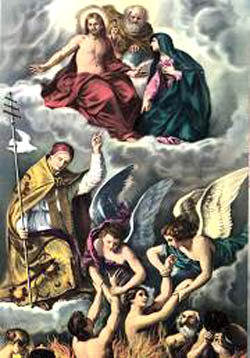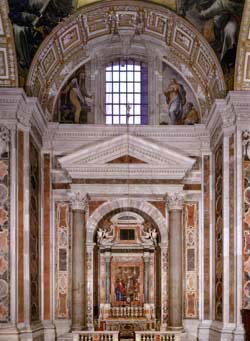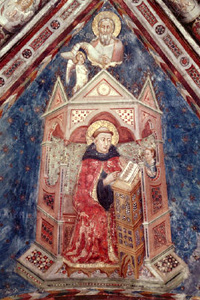A post-Vatican II cradle Catholic, after having just learned about the Thirty Gregorian Masses, has inquired:
- Do these certainly guarantee liberation of the soul (in question) from Purgatory?
- Why has this practice been discontinued?
- Where can we have Gregorian Masses said?
There is a short answer possible to all these questions. But the first question, about the guaranteed efficacity of these Masses, raises many more questions about the practice, especially its origin. In turn, the origin tells us a lot about Catholic belief and piety, and the influence of that amazing saintly Pope, Gregory the Great (d. 604).
First, let me offer a few facts about the Gregorian Thirty, as they are called, for readers who may not be familiar with the practice. The Gregorian Masses is a practice founded by Pope Gregory the Great that became a tradition in the Benedictine Monasteries: If 30 Masses are offered on 30 consecutive days without interruption for a specific soul in Purgatory, it is believed that the soul will leave Purgatory and enter Heaven. These Masses may be offered only for the dead. It does not matter if they are low or high Masses.

St. Gregory the Great saving the souls of Purgatory through the Thirty Gregorian Masses |
Do the Gregorian Masses genuinely guarantee liberation of the soul in question from the purifying punishment of Purgatory?
The history of the “Thirty Mass” practice goes back to the year 590 AD in St. Andrew’s Monastery in Rome, founded by St. Gregory the Great in his own family home around 570.
After his election as Pope in 590, one of the monks, Justus by name, became ill. So he admitted to a lay friend, Copiosus, that he had hidden three gold pieces among his medications years before, when he was professed a monk. Both, in fact, were former physicians. And sure enough, the other monks found the gold when seeking the medication for Justus.
The Founder monk, now Pope Gregory, hearing of this scandalous sin against Holy Poverty, called in the Abbot of his beloved monastery, and ordered the penalty of solitary confinement for Justus, even though he was dying, and ordered his burial not in the cemetery but in the garbage dump. Copiosus told his wretched friend of this decision. Moreover, the community were to recite over his dreadful grave the words of St. Peter to Simon the Magician: “May thy money perish with thee” (Acts 8:20).
The Pope’s desired result was achieved: Justus made a serious repentance, and all the monks a serious examination of conscience. Justus then died, but the matter did not, for thirty days later Pope Gregory returned to the monastery filled with concern for Justus, who would now be suffering the grim temporal punishment of Purgatory’s fire for his sins. “We must,” said Gregory to the Abbot, “come by charity to his aid, and as far as possible help him to escape this chastisement. Go and arrange Thirty Masses for his soul, so that for thirty consecutive days the Saving Victim is immolated for him without fail.” And so it was done.
Some days later, Justus appeared in a vision to his friend Copiosus and said, “I have just received the Communion pardon and release from Purgatory because of the Masses said for me.” The monks did a calculation, and noted that it was exactly thirty days since the Thirty Masses had begun for Justus. They shared this great consolation with each other, with their Abbott and with Pope Gregory, whose personal authority guarantees its truth, for he wrote the full account of it in his Book of Dialogues, which became very popular.
An approved tradition, but not an official one
Is, then the practice of the Thirty Gregorian Masses officially guaranteed by the Church to rescue the given soul from Purgatory into Heaven? As far as I know, no, they are not officially guaranteed, because although we have here a practice approved by the Church, it is not an institution in which the Church engages her official authority. The case of Justus is a consoling story, but it depends on a vision to Copiosus, which is in the category of private revelation, worthy of our trust perhaps, but not equal to a vision to St. Joseph from Gabriel, for instance.
Nevertheless, along with Copiosus, a goodhearted Catholic physician, we also have St. Gregory the Great acting a striking scene out of his powerful, blessed and awe-inspiring role in the Holy Church. He has helped to consolidate the Catholic habit of prayers for the departed. For centuries after his death, the Gregorian Thirty seems to have been widely observed in Benedictine monasteries. A monk of Cluny (d. 1093) records this fact, and only the “big five” days are allowed to interrupt the thirty: These are Christmas, Easter, and the Holy Week Triduum.
Masses on privileged altars

The altar of Pope Gregory the Great, a privileged altar in Clementine Chapel at St. Peter's Basilica |
Catholic piety has added other details to this practice of the Gregorian Masses without strict obligation, such as use of a “privileged altar” in a particular church, and the choice of the Requiem Mass for the Dead when allowed by the rubrics.
As for the “privileged altar,” mentioned above, such became the title of the altar habitually used by St. Gregory for Mass when he was Abbot at St. Andrew’s.
This same privilege came to be extended to certain other altars, first at Rome, then elsewhere. Such a “privileged altar” ad instar [like the original] required only one Mass for a departed soul to be set free from Purgatory’s pains. Under Pope Leo XIII, the Vatican declared it “pious and lawful” to hold such a belief: namely, a conviction that the same benefit of the Gregorian Thirty Masses could be had from a single Mass at such an altar, privileged to invoke a plenary indulgence (remission of all temporal punishment due for sins) for the soul for whom the Mass is offered there.
A number of other questions have arisen over the years and the ages regarding the Gregorian Thirty Masses. For example, a change of priests or of altar during the thirty days is not forbidden. Moreover, Masses and prayers may be offered publicly for the same soul even long after the Thirty is over, and indeed, Catholic piety is inclined spontaneously to do so. The sturdy persistence of belief in Purgatory, and of prayers and sacrifices for the departed remains today, much to the credit of that remarkable Pope Gregory the Great, fourteen centuries after his death.
Why were they discontinued?

St. Gregory the Great helped establish monastic discipline - Sacro Speco, Italy |
Now, let me go on to question 2: Why has this practice been discontinued? And I answer that at the time of this writing, it is about a week since I myself completed the Thirty Gregorian Masses for the soul of C.N. In a short time, I shall begin another thirty for the deceased father of a friend. The practice is evidently not totally discontinued.
But I speak as a retired priest who has returned to Tradition. Today my “congregation” is much smaller than what I used to have. Thus I am free to accept the occasional Gregorian Thirty. The number of available and good parish priests being much reduced today, the parish secretary probably has to decline many requests for “the Thirty Masses,” which must be said for a continuous 30 days without any break.
I should add that ecumenism probably works to render low-profile or to discontinue the Thirty Mass practice. It is a bold and emphatic reminder of the doctrine of Purgatory and of the importance of prayers and Masses said for the faithful departed, things which are outside Protestant belief, and therefore apt to raise Protestant hackles. I am not even sure that the young priests today are taught the edifying history or the practice of the Thirty Gregorian Masses.
Where can they be said?
This leads to question 3: Where can we have Gregorian Masses said? And the answer is, any available, willing priest whose Mass timetable is not too heavily laden with unsatisfied stipend Masses awaiting reasonably prompt celebration. I hope this answer is clear.
In the past, the priests at contemplative monasteries would often accept requests to say the Gregorian Thirty. I pray that true monastic vocations will soon be multiplied, so that there will always be priests at your neighborhood monastery willing and able to accept the task of the Gregorian Thirty Masses, that is, Masses said thirty days in a row for a particular deceased.
Eternal rest grant unto them, O Lord.
And let perpetual light shine upon them.
May they rest in peace, Amen.

Posted September 15, 2006

Related Topics of Interest
 Don’t Forget Sacramentals - Aids to the Spiritual Life Don’t Forget Sacramentals - Aids to the Spiritual Life
 Restoration: Let's Begin with the Veil Restoration: Let's Begin with the Veil
 Addressing Priests and Religious Addressing Priests and Religious
 Problems and Solutions regarding Natural Marriage and Civil Marriage Problems and Solutions regarding Natural Marriage and Civil Marriage
 La Conquistadora - Our Country's Oldest Madonna La Conquistadora - Our Country's Oldest Madonna
 The Symbol of the Crown in the Reign of Mary The Symbol of the Crown in the Reign of Mary

|